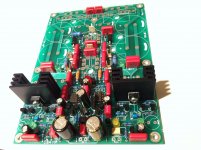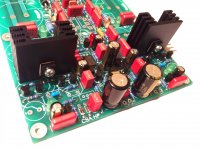Sonny,
I have one question about your TSSA design:
I think I understand the reasons you included the i/p stage hawsford cascode in this design ( about 3db better PSNRR + constant voltage ) but I was not so sure about why you included the CFP - In spice I could not see much of a difference - would be interested to here your thinking on that.
thanks
mike
I have one question about your TSSA design:
I think I understand the reasons you included the i/p stage hawsford cascode in this design ( about 3db better PSNRR + constant voltage ) but I was not so sure about why you included the CFP - In spice I could not see much of a difference - would be interested to here your thinking on that.
thanks
mike
Last edited:
Higher input impedance, allows higher bias current on input pair and wider bandwith with higher current.
goddammit... i like analog electronics... I want to design stuff and build them and feel the awesome feeling you get when you build something yourself, but i suck so much at analog, it ain't even funny 🙁
Hi Tsiros 
As you can see this and SSA thread are not just about one specific schematic, its PCB and bill of material. They're much more, they're about exploring ideas, experimenting, letting people express their opinion about certain solutions, etc. OK both are mainly oriented to current feedback amplifiers, their history (SSA thread) and modern designs implementations with quite some special new and very capable semiconductors.
Very nice about electronics is that the knowledge can step up gradually and very consistently, since any practically proven circuit has 100% repeatability especially with modern parts.
So my advice to you is never give up, be open minded, learn, think about ideas, test them practically and over the time you can become skillful designer of your own ideas based on common electronics knowledge.
Regards Andrej 😉

As you can see this and SSA thread are not just about one specific schematic, its PCB and bill of material. They're much more, they're about exploring ideas, experimenting, letting people express their opinion about certain solutions, etc. OK both are mainly oriented to current feedback amplifiers, their history (SSA thread) and modern designs implementations with quite some special new and very capable semiconductors.
Very nice about electronics is that the knowledge can step up gradually and very consistently, since any practically proven circuit has 100% repeatability especially with modern parts.
So my advice to you is never give up, be open minded, learn, think about ideas, test them practically and over the time you can become skillful designer of your own ideas based on common electronics knowledge.
Regards Andrej 😉
Assembly of CSA PCB-s progressing slowly, still long way from starting CSA thread, since I decided that the right moment will be when CSA will be throughly tested and installed in my system. 
First I have to check front-end stage functionality and performance, but nothing before receiving Vishay trimmers and Murata compensating capacitors. So still a lot of work ahead ... 🙄

First I have to check front-end stage functionality and performance, but nothing before receiving Vishay trimmers and Murata compensating capacitors. So still a lot of work ahead ... 🙄
Attachments
Hi All. Just wanted to say that All boards are assemblied.
There is a little error in the diagram. There is a 680r resistor instead of 100r in one of the ccs.
The diagram Will be updated, and also the assembly and adjustment procedure Will be uploaded in the weekend. That Will be just a Day before the first boards Will arive.
So we Will start to sent them out tomorrow.
There is a little error in the diagram. There is a 680r resistor instead of 100r in one of the ccs.
The diagram Will be updated, and also the assembly and adjustment procedure Will be uploaded in the weekend. That Will be just a Day before the first boards Will arive.
So we Will start to sent them out tomorrow.
Sonny,
I have one question about your TSSA design:
I think I understand the reasons you included the i/p stage hawsford cascode in this design ( about 3db better PSNRR + constant voltage ) but I was not so sure about why you included the CFP - In spice I could not see much of a difference - would be interested to here your thinking on that.
thanks
mike
No, not at Open loop. The distortion Will go Down a little . And the 're' Will be lowered. But at the same time the current through base of the transistor Will stay at ~1uA. Without cfp it is ~10uA. This Will lower the thermally drift of the input offset current.
goddammit... i like analog electronics... I want to design stuff and build them and feel the awesome feeling you get when you build something yourself, but i suck so much at analog, it ain't even funny 🙁
Start with the very first circuit in this thread. 🙂

 By the way Michael. While my assembly lady was assembling smt parts i have been tweaking on the circuit.
By the way Michael. While my assembly lady was assembling smt parts i have been tweaking on the circuit. The first reaction from my wife...." Ummm i Can hear an improvement... I am not an audio Girl .... But i Can hear an improvement .. There is more information in the sound"..

Sonny, now that you have explained it, the logic of your i/p scheme is very clear.
thanks
Can we see your tweaks ?
thanks
Can we see your tweaks ?
Last edited:
Hi all. I have uploaded the TSSA V1.6 assembly and adjustment guide.
http://www.diyaudio.com/forums/sito-audio/217616-tssa-v1-6-docs-buyers-list.html#post3137897
http://www.diyaudio.com/forums/sito-audio/217616-tssa-v1-6-docs-buyers-list.html#post3137897
Following is shipped today:
Salas
Harry C.
Mike M.
Justin F.
Boris C.
Brian C.
Simon.
George and Vitalie will ship monday.
Salas
Harry C.
Mike M.
Justin F.
Boris C.
Brian C.
Simon.
George and Vitalie will ship monday.
It should not give much trouble to assemble. Only the blade connectors need a little force to insert.
I will send feedback - but in the meantime, did you measure or calculate the o/p impedance ?
cheers
mike
cheers
mike
Zout = 0.49Ohm
If it is not good enough. Change to ALF16N16W and ALF16P16W from Semelab.
The Zout will be the half .
If it is not good enough. Change to ALF16N16W and ALF16P16W from Semelab.
The Zout will be the half .
Group feedback will have group delay, hehe. 😀
That is fun!!!!!!!!! 😀😀😀😀😀😀😀😀😀




- Home
- Amplifiers
- Solid State
- TSSA - The Simplest Symmetrical Amplifier

